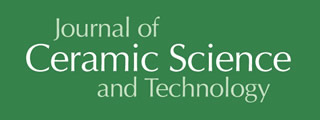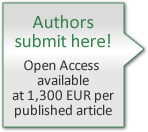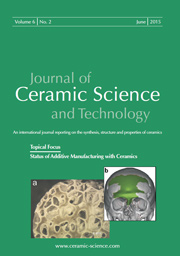Articles
All articles | Recent articles
The Effect of Different La-Containing Starting Materials on the Synthesis, Sintering, and Li+-Conductivity of Li3xLa2/3-xTiO3
A.C. Sutorik1, C. Cooper1, M.D. Green1, J. Wolfenstine2, G. Gilde1
1 U.S. Army Research Laboratory, RDRL WMM E, Building 4600, Aberdeen Proving Ground, D 21005, USA
2 U.S. Army Research Laboratory, RDRL SED C, 2800 Powder Mill Road, Adelphi, MD 20783, USA
received September 20, 2012, received in revised form November 1, 2012, accepted November 9, 2012
Vol. 4, No. 2, Pages 59-68 DOI: 10.4416/JCST2012-00035
Abstract
Li3xLa2/3-xTiO3 is a promising ceramic electrolyte for high energy density Li-batteries. The material is usually prepared from solid state reactions between Li2CO3, La2O3, and TiO2, but the hydroscopic nature of La2O3 leads to inconsistencies in formulation and synthetic outcome which can impact the phase formation and corresponding Li-conductivity of the final ceramic. To address this issue, La carbonate and hydroxides have been evaluated as starting materials for solid state synthesis of Li3xLa2/3-xTiO3 powders and sintered ceramic. The different La-starting materials are all prepared from precipitation reaction as high surface area powders. These are characterized for phase, particle size, particle morphology, and ceramic yield (by thermal gravimetric analysis). The La starting materials are then mixed with the desired stoichiometric amounts of Li2CO3 and TiO2. The mixtures are calcined at 1100 °C for 1 h before being pressed into green parts and sintered at either 1200 or 1300 °C for 6 h. Under nearly all conditions investigated, the formulations using the La-carbonate-based starting material lead to ceramics with the highest bulk density, the highest degree of cubic superstructure formation, and the highest lattice Li+-conductivity. Total conductivity, however, appears largely insensitive to the La starting material used.
![]() Download Full Article (PDF)
Download Full Article (PDF)
Keywords
Keywords: Li+-conducting ceramic, Li-air battery, ceramic electrolyte, lithium lanthanum titanate
References
1 Lee, J.-S., Kim, S.T., Cao, R., Choi, N.-S., Lui, M., Lee, K.T., Cho, J.: Metal-air batteries with high energy Density: Li-air versus Zn-air, Adv. Energy Mater., 1, 34 – 50, (2011).
2 Kraytsberg, A., Ein-Eli, Y., Review on Li-air batteries – opportunities, limitations, and perspective, J. Power Sources, 196, 886 – 893, (2011).
3 Kumar, B., Kumar, J., Leese, R., Fellner, J.P., Rodrigues, S.L., Abraham, K.M.: A solid-state, rechargeable, long cycle life lithium-air battery, J. Electrochem. Soc., 157, A50 – A54, (2010).
4 Abraham, K.M., Jiang, Z.: A polymer electrolyte-based rechargeable Lithium/Oxygen battery, J. Electrochem. Soc., 143, 1 – 5, (1996).
5 Abraham, K.M., Jiang, Z., Carroll, B.: Highly conductive PEO-like polymer electrolytes, Chem. Mater., 9, 1978 – 1988, (1997).
6 Kuboki, T., Okayama, T., Ohsaki, T., Takami, N.: Lithium-air batteries using hydrophobic room temperature ionic liquid electrolyte, J. Power Sources, 146, 766 – 769, (2005).
7 Visco, S.J., Katz, B.D., Nimon, Y.S., DeJonghe, L.C.: Protected active metal electrode and battery cell structures with non-aqueous interlayer architecture, U.S. Patent 7,282, 295 B2, (2007).
8 Kowaluk, I., Read, J., Salomon, M.: Li-air batteries: A classic example of limitations owing to solubilities, Pure Appl. Chem., 79, 851 – 860, (2007).
9 Wolfenstine, J., Allen, J.L.: Reaction of Li0.33La0.57TiO3 with water, J. Mater. Sci., 43, 7247 – 7249, (2008).
10 Kotobuki, M., Suzuki, Y., Munakata, H., Kanamura, K., Sato, Y., Yamamoto, K., Yoshida, T.: Compatibility of LiCoO2 and LiMn2O4 cathode materials for Li0.55La0.35TiO3 electrolyte to fabricate all-solid-state lithium battery, J. Power Sources, 195, 5784 – 5788, (2010).
11 OudenHoven, J.F.M., Baggetto, L., Notten, P.H.L.: All-Solid-state lithium-ion Microbatteries: A review of various three-dimensional concepts, Adv. Energy Mater., 1, 10 – 33, (2011).
12 Inaguma, Y., Liquan, C., Itoh, M., Nakamura, T., Uchida, T., Ikuta, H., Wakihara, M.: High ionic conductivity in lithium lanthanum titanate, Solid State Commun., 86, 689 – 693, (1993).
13 Stramare, S., Thangadurai, V., Weppner, W.: Lithium lanthanum titanates: A review, Chem. Mater., 15, 3974 – 3990, (2003).
14 Inaguma, Y., Chen, L., Itoh, M., Nakamura, T.: Candidate compounds with perovskite structure for high lithium ionic conductivity, Solid State Ionics, 70/71, 196 – 202, (1994).
15 Harada, Y., Ishigaki, T., Kawai, H., Kuwano, J.: Lithium ion conductivity of polycrystalline perovskite La0.67-xLi3xTiO3 with ordered and disordered arrangements of the A-site ions, Solid State Ionics, 108, 407 – 413, (1998).
16 Sutorik, A.C., Green, M.D., Cooper, C., Wolfenstine, J., Gilde, G.: The comparative influences of structural ordering, grain size, Li-content, and bulk density on the Li+-conductivity of Li0.29La0.57TiO3, J. Mater. Sci., 47, 6992 – 7002, (2012).
17 Wöhrle, T., Gomez-Romero, P., Fries, T., West, K., Palacin, M.R., Casan-Pastor, N.: Sol-gel synthesis of the lithium ion conducting perovskite La0.57Li0.3TiO3: effect of synthesis and thermal treatments on the structure and conducting properties, Ionics, 2, 442 – 445, (1996).
18 Kitaoka, K., Kozuka, H., Hashimoto, T., Yoko, T.: Preparation of La0.5Li0.5TiO3 perovskite thin films by the sol-gel method, J. Mater. Sci., 32, 2063 – 2070, (1997).
19 Pham, Q.N., Bohnk̩, C., Crosnier-Lopez, M.-P., Bohnk̩, O.: Synthesis and characterization of nanostructure fast ionic conductor Li0.30La0.56TiO3, Chem. Mater., 18, 4385 Р4392, (2006).
20 Shin, J.-W., Hong, C.-H., Yoon, D.-H.: Effects of TiO2 starting materials on the solid -state formation of Li4Ti5O12, J. Am. Ceram. Soc., 95, 1894 – 1900, (2012).
21 Bauerle, J.E.: Study of solid electrolyte polarization by a complex admittance method, J. Phys. Chem. Solids, 30, 2657 – 2670, (1969).
22 Huggins, R.A.: Simple method to determine electronic and ionic components of the conductivity in mixed conductors: A review, Ionics, 8, 300 – 313, (2002).
23 Wurst, J.C., Nelson, J.A.: Lineal intercept technique for measuring grain size in two-phase polycrystalline ceramics, J. Am. Ceram. Soc., 55, 109, (1972).
24 Harada, Y., Hirakoso, Y., Kawai, H., Kuwano, J.: Order-disorder of the A-site ions and lithium ion conductivity in the perovskite solid solution La0.67-xLi3xTiO3, Solid State Ionics, 121, 245 – 251, (1999).
25 Ban, C.W., Choi, G.M.: The effect of sintering on the grain boundary conductivity of lithium lanthanum titanates, Solid State Ionics, 140, 285 – 292, (2001).
26 Thangadurai, V., Weppner, W.: Recent progress in solid oxide and lithium ion conducting electrolytes research, Ionics, 12, 81 – 92, (2006).
27 Mei, A., Wang, X.-L., Lan, J.-L., Feng, Y.-C., Gen, H.-X, Lin, Y.-H., Nan, C.-W.: Role of amorphous boundary layer in enhancing ionic conductivity of lithium-lanthanum-titanate electrolyte, Electrochim. Acta., 55, 2958 – 2963, (2010).
Copyright
Göller Verlag GmbH


